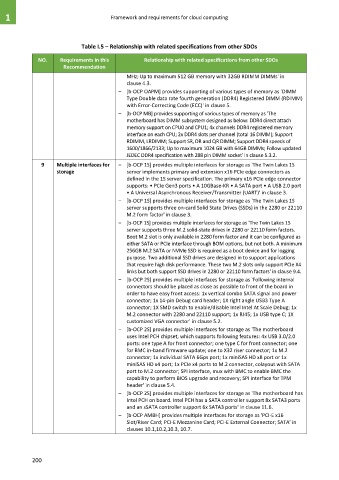Page 208 - Cloud computing: From paradigm to operation
P. 208
1 Framework and requirements for cloud computing
Table I.5 – Relationship with related specifications from other SDOs
NO. Requirements in this Relationship with related specifications from other SDOs
Recommendation
MHz; Up to maximum 512 GB memory with 32GB RDIMM DIMMs' in
clause 4.3.
– [b-OCP OAPM] provides supporting of various types of memory as 'DIMM
Type Double data rate fourth generation (DDR4) Registered DIMM (RDIMM)
with Error-Correcting Code (ECC)' in clause 5.
– [b-OCP MB] provides supporting of various types of memory as 'The
motherboard has DIMM subsystem designed as below: DDR4 direct attach
memory support on CPU0 and CPU1; 4x channels DDR4 registered memory
interface on each CPU; 2x DDR4 slots per channel (total 16 DIMM); Support
RDIMM, LRDIMM; Support SR, DR and QR DIMM; Support DDR4 speeds of
1600/1866/2133; Up to maximum 1024 GB with 64GB DIMMs; Follow updated
JEDEC DDR4 specification with 288 pin DIMM socket' in clause 5.3.2.
9 Multiple interfaces for – [b-OCP 1S] provides multiple interfaces for storage as 'The Twin Lakes 1S
storage server implements primary and extension x16 PCIe edge connectors as
defined in the 1S server specification. The primary x16 PCIe edge connector
supports: • PCIe Gen3 ports • A 10GBase-KR • A SATA port • A USB 2.0 port
• A Universal Asynchronous Receiver/Transmitter (UART)' in clause 3.
– [b-OCP 1S] provides multiple interfaces for storage as 'The Twin Lakes 1S
server supports three on-card Solid State Drives (SSDs) in the 2280 or 22110
M.2 form factor' in clause 3.
– [b-OCP 1S] provides multiple interfaces for storage as 'The Twin Lakes 1S
server supports three M.2 solid-state drives in 2280 or 22110 form factors.
Boot M.2 slot is only available in 2280 form factor and it can be configured as
either SATA or PCIe interface through BOM options, but not both. A minimum
256GB M.2 SATA or NVMe SSD is required as a boot device and for logging
purpose. Two additional SSD drives are designed in to support applications
that require high disk performance. These two M.2 slots only support PCIe X4
links but both support SSD drives in 2280 or 22110 form factors' in clause 9.4.
– [b-OCP 2S] provides multiple interfaces for storage as 'Following internal
connectors should be placed as close as possible to front of the board in
order to have easy front access: 1x vertical combo SATA signal and power
connector; 1x 14-pin Debug card header; 1X right angle USB3 Type A
connector; 1X SMD switch to enable/disable Intel Intel At Scale Debug; 1x
M.2 connector with 2280 and 22110 support; 1x RJ45; 1x USB type C; 1X
customized VGA connector' in clause 5.2.
– [b-OCP 2S] provides multiple interfaces for storage as 'The motherboard
uses Intel PCH chipset, which supports following features: 4x USB 3.0/2.0
ports: one type A for front connector; one type C for front connector; one
for BMC in-band firmware update; one to X32 riser connector; 1x M.2
connector; 1x individual SATA 6Gps port; 1x miniSAS HD x8 port or 1x
miniSAS HD x4 port; 1x PCIe x4 ports to M.2 connector, colayout with SATA
port to M.2 connector; SPI interface, mux with BMC to enable BMC the
capability to perform BIOS upgrade and recovery; SPI interface for TPM
header' in clause 5.4.
– [b-OCP 2S] provides multiple interfaces for storage as 'The motherboard has
Intel PCH on board. Intel PCH has a SATA controller support 8x SATA3 ports
and an sSATA controller support 6x SATA3 ports' in clause 11.6.
– [b-OCP AMBH] provides multiple interfaces for storage as 'PCI-E x16
Slot/Riser Card; PCI-E Mezzanine Card; PCI-E External Connector; SATA' in
clauses 10.1,10.2,10.3, 10.7.
200

